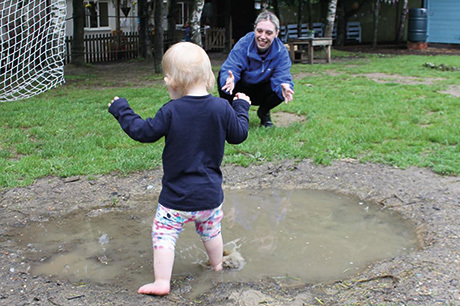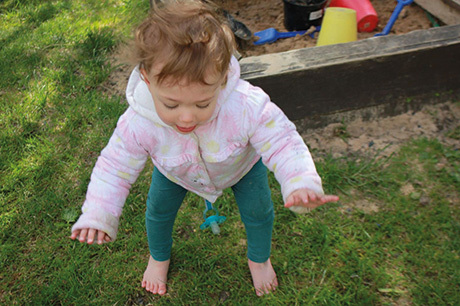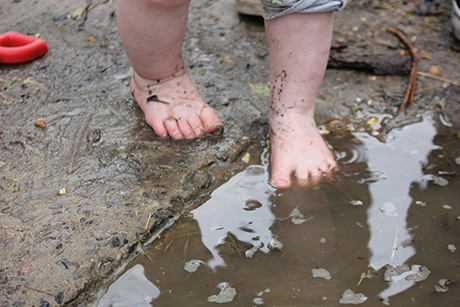
Download the PDF of this article
Allowing young children to go barefoot provides a wealth of benefits. Experiencing different textures underfoot helps children gather information about the ground and the world around them, while podiatrists and academics suggest walking barefoot improves posture, foot strength and proprioception.
Walking without shoes also stimulates the senses in a different way and can be especially helpful for children with additional needs, such as sensory processing problems.
Inspired by the increasing popularity of barefoot play in Malaysia, where nursery director Hayley Peacock attended a conference this year, Little Barn Owls in Horsham launched a barefoot play project in May.
Sarah Rumbold, baby practice lead at the nursery, says barefoot play sessions, which she runs for all 20 six- to 18-month-olds attending the setting, were started deliberately on humid, rainy days so the babies could first experience warm puddles before moving on to more challenging surfaces.
‘Even the youngest children, who are only just starting to sit, can encounter the outdoors with their feet,’ she says. ‘We wanted to introduce the concept slowly, so as not to overstimulate them too quickly. We started by taking just their shoes off when outside, then their socks as their confidence grew. We didn’t want to make too much of a big deal of it, but wanted them to just carry on playing and not notice they were doing anything different.’

Over time, practitioners introduced the babies to different conditions. ‘I wanted to be realistic by helping the babies experience a range of weather in no shoes, not just sunny days,’ Ms Rumbold says. ‘This meant taking them outside over and over again, respecting that each child would take their own time to feel comfortable.’
As the children gained confidence, staff introduced a range of surfaces, including long grass, concrete and rubber chipping. However, for older children who were more used to wearing shoes, the idea of running around without the safety of shoes posed more of a challenge.
‘This is a very new concept for toddlers, the majority of whom will have recently worked very hard on trying to walk in their first shoes, so they can initially be nervous or reluctant,’ explains Ms Rumbold.
‘When a child is anxious or nervous, they might say things like “I’m not allowed to do that”. This is where it is important as educators to recognise each child’s cultural capital and support them through the process at their own pace.’
Ms Rumbold’s colleague, Katrina Otero, came up with the idea of bringing outdoor textures inside to help older children get used to the sensation first, placing materials such as grass, soil, wood chipping and hay on long strips of lino.
‘This helped build the confidence of the children who were slightly unsure, so they were ready and prepared to encounter those materials outside,’ says Ms Rumbold.
However, it was not only the children who had concerns. ‘I realised I also had preconceived fears of how not wearing shoes could be dangerous,’ adds Ms Rumbold, ‘but we spoke a lot about the textures of different environments, and how there might be some things we choose not to step on.’
To help combat these fears, practitioners took their shoes off too in order to boost children’s confidence and comfort with the idea, as well as their own.
‘It enables staff to share language associated with the feelings and textures they encounter,’ says Ms Rumbold. ‘It also actively shows children we are interested in their learning and gives them a secure base to explore with confidence.’
Staff also worked hard on informing parents about the benefits of barefoot play. ‘Children in the UK are often given shoes even before they can walk, but babies don’t need to wear them until they have been walking for at least six weeks,’ Ms Rumbold explains. ‘Parents and carers often don’t know this.’

As a result of explaining these ideas, the nursery received plenty of positive feedback from families. ‘Lots of parents shared how they plan to continue barefoot play at home,’ Ms Rumbold says. ‘It was also great to hear experiences from parents from different cultures who had been brought up wearing no shoes, and how they were rooting for our project.’
The benefits of barefoot play have been observed across all ages at Little Barn Owls, with children growing in curiosity and confidence.
‘The children are now experiencing the joy and freedom of pushing their own boundaries and limits within their environment,’ says Ms Rumbold. ‘There is now little hesitancy when encountering new environments outside.’
One little boy, aged 14 months, convinced his older sister, who had not had any experience of barefoot play, to join him jumping in puddles after she initially seemed nervous about the concept.
Ms Rumbold recalls, ‘She was watching him and kept starting to take her wellies off but would put them straight back on again whenever staff went near. After a while he grabbed her and they splashed around together. He had expressed to her that he knew it was safe, and she understood that from him and was able to join in and enjoy it.
‘It was almost a role reversal of ages and showed the impact and influence of the setting’s work with him. It was a beautiful moment and a very cool breakthrough.’
Children have also discovered that the concept does not have to be limited to outdoors, adds Ms Rumbold.
She says, ‘We have recently been working on circuit boards and keyboards and some of the babies have started playing with them, unprompted, using only their feet. It’s amazing to see them experimenting with their whole bodies instead of just their hands.’
The project will continue indefinitely at Little Barn Owls, with sessions now running every other day for all children at the nursery. Ms Rumbold is an active proponent of introducing barefoot play to all settings.
‘Instead of this being a research project, it is a continual learning tool that we will share with each child as they develop their confidence,’ she says. ‘We will continue to provide the same experience for all new children starting at the nursery so they will become confident exploring with no shoes on. In fact, when given the choice, we have found they would rather be barefoot, especially older children.
‘I don’t just want this to be something that we do in a nursery in Horsham. I want it to be shared throughout the country and would love to open dialogue with other settings to hear how they have experienced the same concept.’
BENEFITS OF BAREFOOT
Developing a sense of body awareness, or proprioception
Babies and children learn about their bodies, where different bits are and what they can do with them through sensations they receive through nerve endings. Feet and toes are jam-packed with nerve endings, so children can feel the ground beneath them to develop a sense of where their body is in space and how they can move to safely negotiate their environment.
Wearing shoes limits the development of sensory pathways that promote healthy and functional movement patterns, while looking down to receive information about where to walk increases the risk of losing balance and falling.
Developing a natural, healthy gait
Barefoot walking promotes better biomechanics in terms of distributing weight evenly and efficiently throughout the body. When barefoot, children develop a more natural gait which is gentler, has a shorter stride and puts less pressure through the heels. The knees bend more to cushion each step and the toes help grip and forward movement.
Strengthening the feet and body
When walking barefoot, children can grip the ground more easily using the muscles of their feet and toes. The small muscles in the feet adapt the shape of the foot and body position to the surface. This not only strengthens these muscles but also results in more effective grip and balance, thereby reducing the risk of trips and falls.
Improving safety
Going barefoot helps children learn to assess a situation and adapt to it. If there is a rocky surface, children quickly learn to slow their pace and look for and tread on the most stable parts. When walking barefoot they step with less force and are more likely to notice if they put their feet on something sharp, therefore avoiding injury. A heightened awareness of surroundings and ability to react adaptively in many different situations are skills that will help children assess and adapt to risk in other areas of their lives.
Connecting to the natural environment
Wearing shoes places a barrier between feet and the natural world, reducing the health-promoting effects of spending time in nature. Walking barefoot promotes an affinity for nature which is not only good for the feet, but does wonders for physical development and social and emotional health and well-being.
Adapted from Madeline Avci’s blog for Nature Play QLD, www.natureplayqld.org.au/the-benefits-of-being-barefoot









